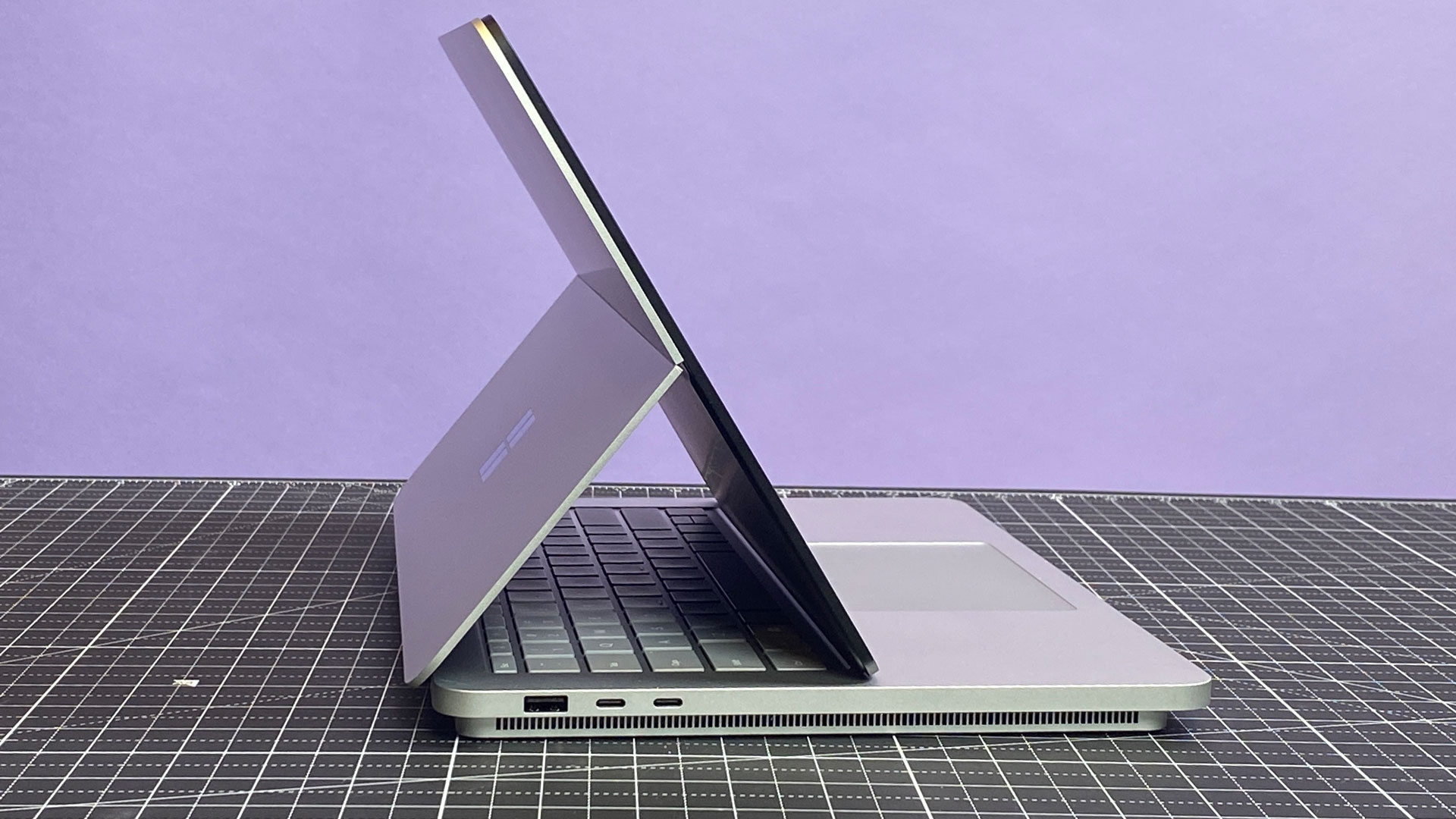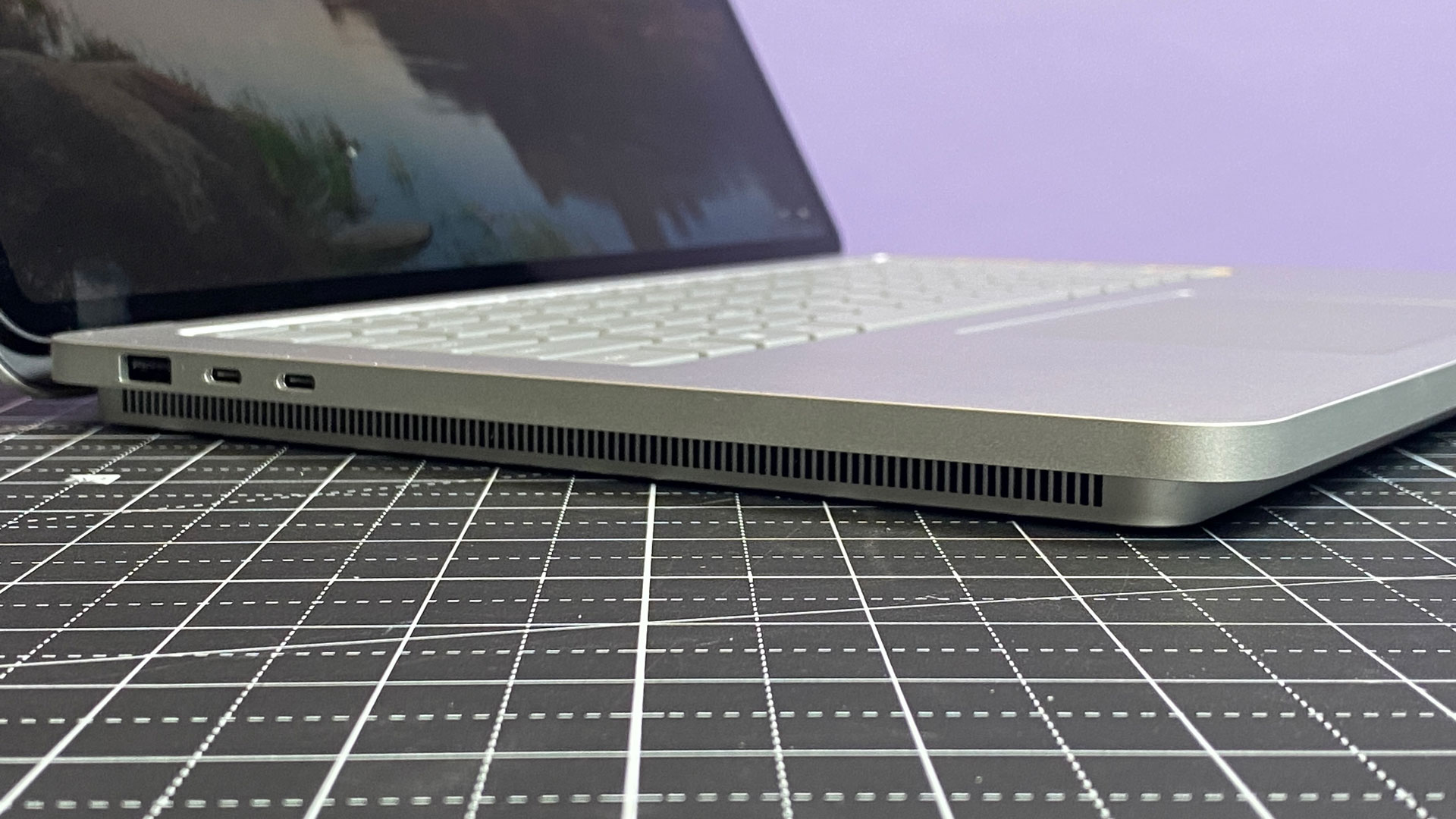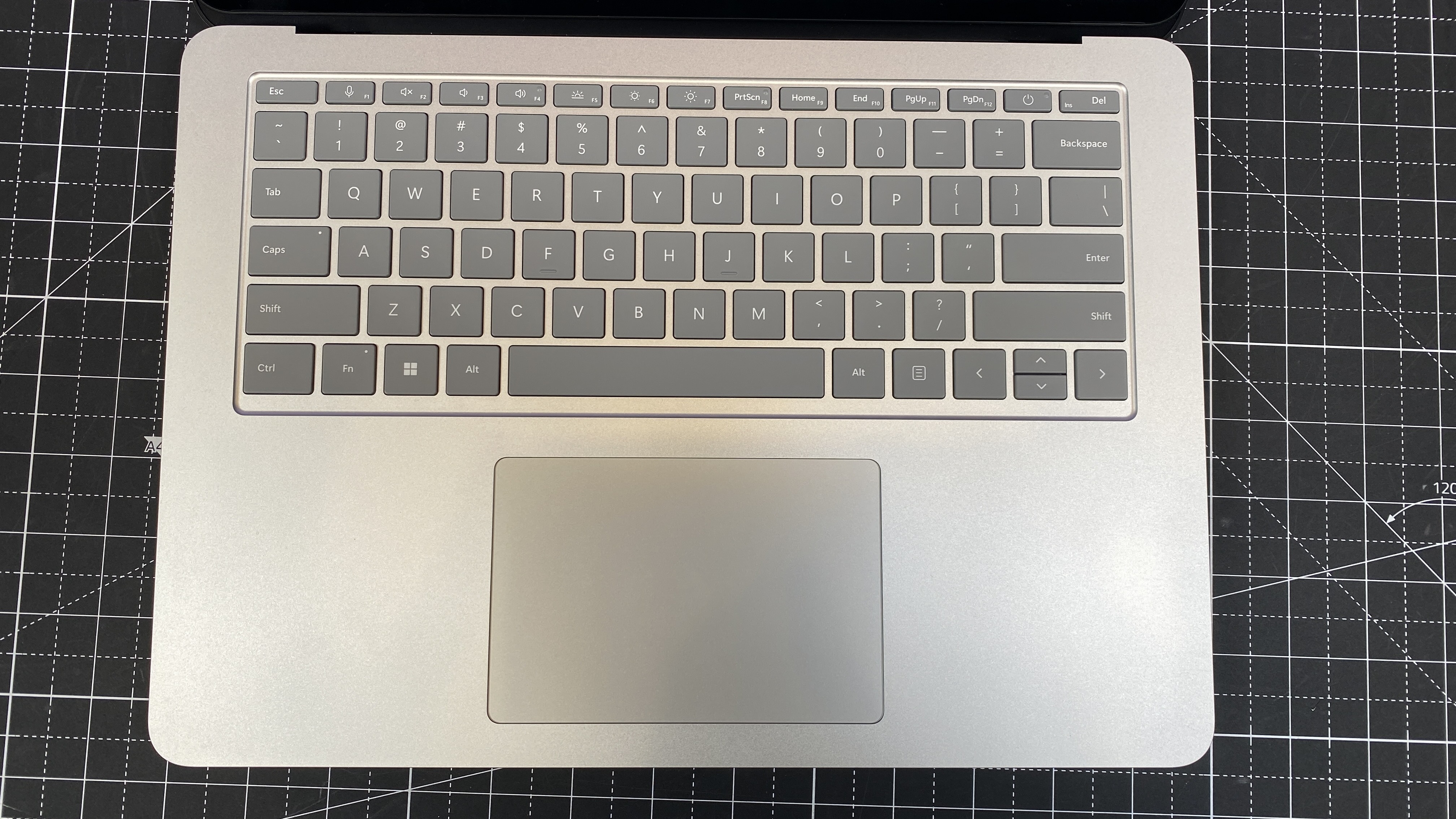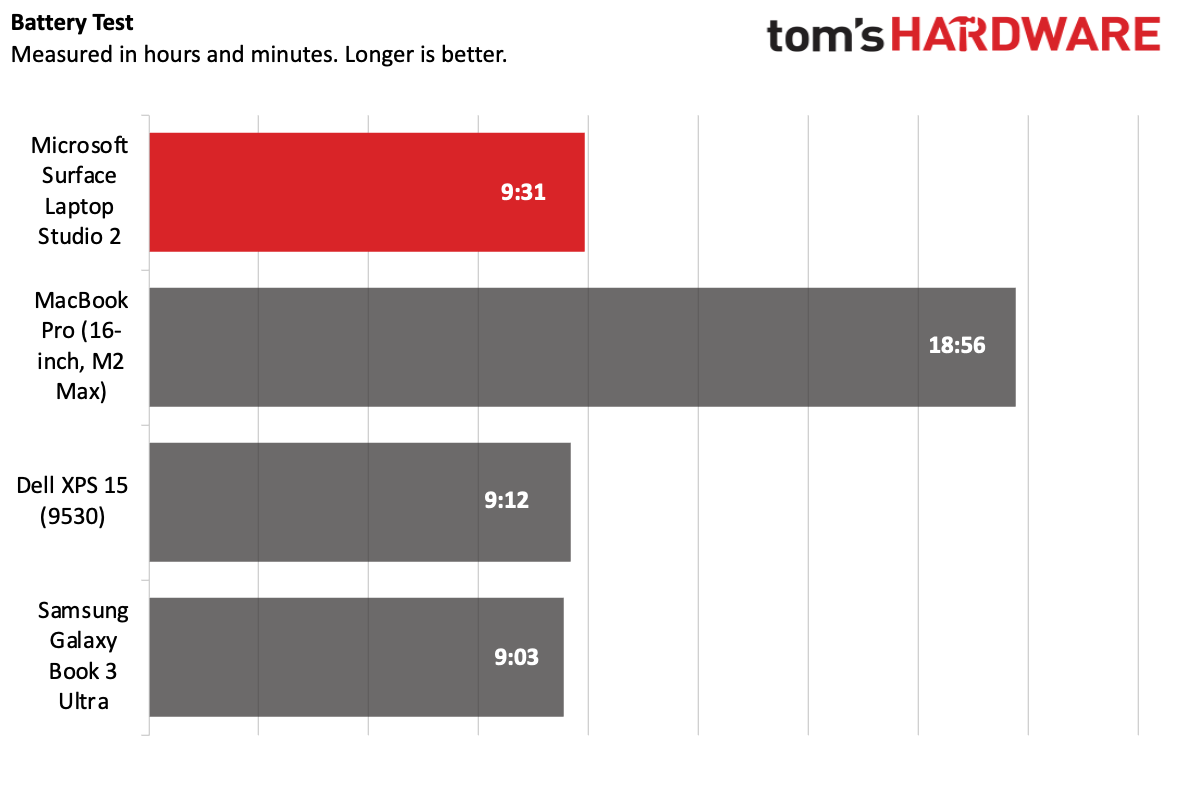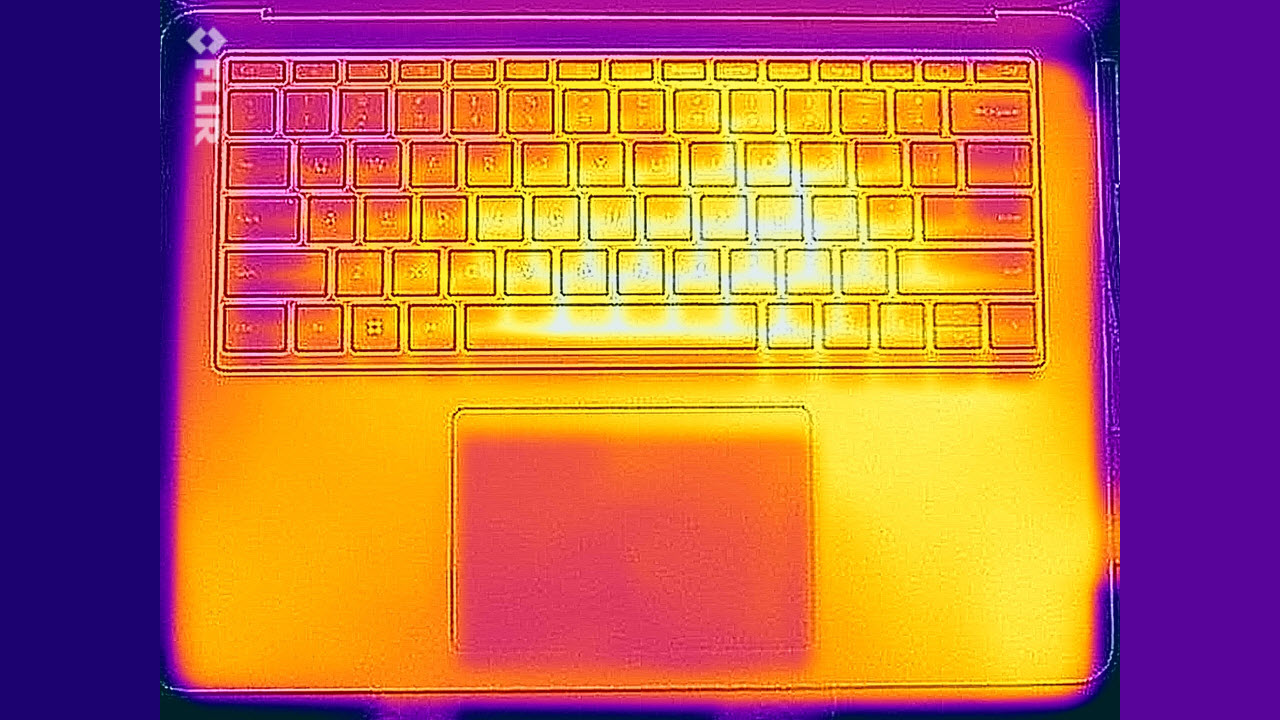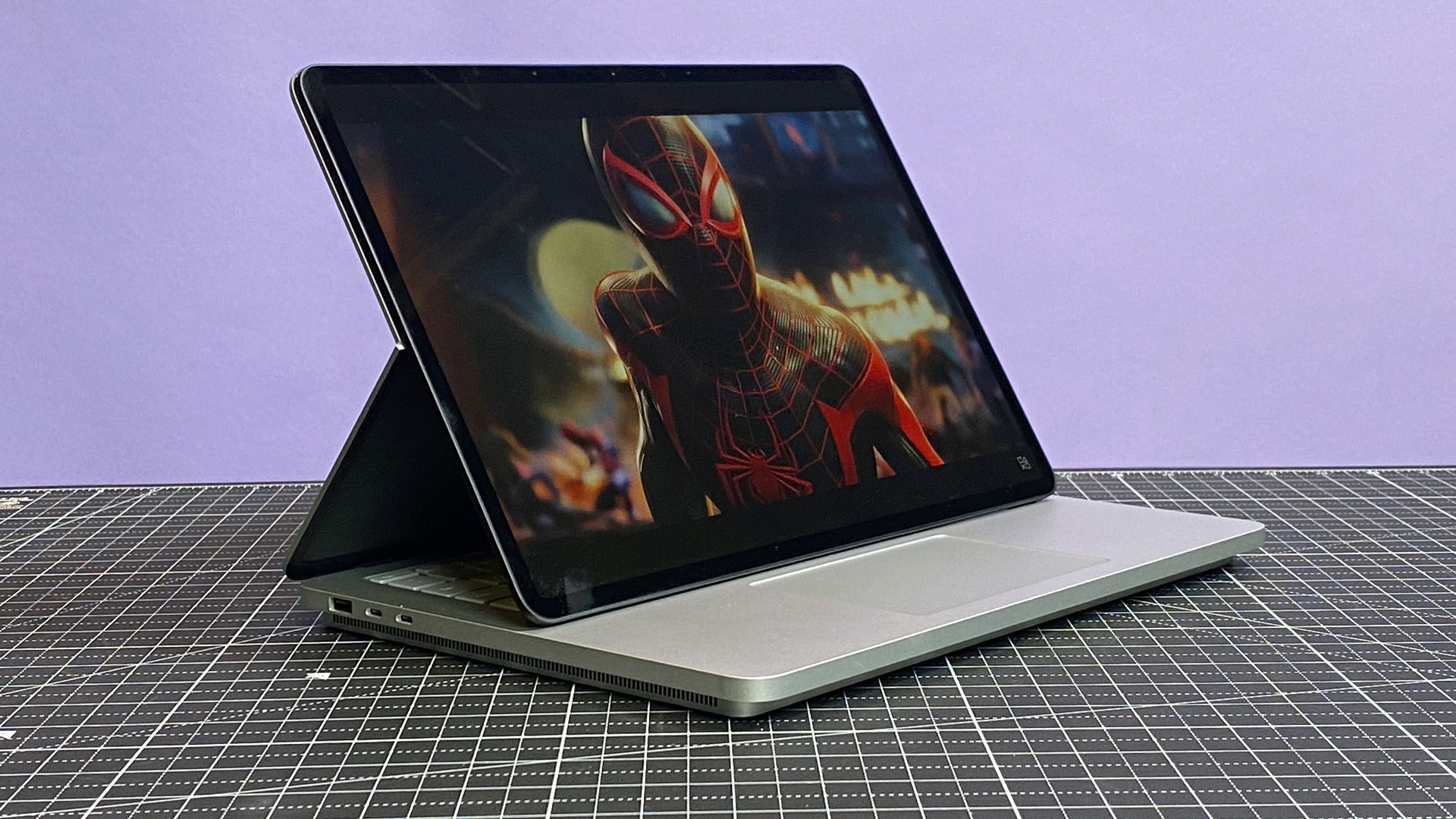Tom's Hardware Verdict
The Microsoft Surface Laptop Studio 2 is more powerful than ever and has the welcome additions of USB Type-A port and microSD card slot. But its GPU is restrained with just 80W, and the system is still expensive and difficult to repair.
Pros
- +
Additional ports and 64GB RAM option are useful for creatives
- +
Runs quiet
- +
Comfortable keyboard and haptic touchpad
- +
Bright display
Cons
- -
GPU has a low 80W max graphics power
- -
Difficult to upgrade yourself
- -
Expensive
Why you can trust Tom's Hardware
The first Microsoft Surface Laptop Studio was a showcase of everything Windows 11 could do. Now, two years later, Microsoft is refreshing it with more power (and, for the first time, 64GB of RAM) and a focus on AI.
If you can call this a redesign, it's a minor one, utilizing anodized aluminum. The bigger changes are that Microsoft has added more ports for using a wider variety of peripherals and storage options, as well as more powerful specs. Those include 13th Gen Intel Core i7 processors, Nvidia RTX 40-series GPUs, and an Intel AI co-processor, the Movidius VPU.
What keeps the Surface Laptop Studio 2 unique is Microsoft's hinge design. Other companies, like Acer and HP, have tried a laptop with a screen that pulls forward, but Microsoft is sticking with it. If you're an artist or just love using OneNote and other productivity apps that improve with the use of a stylus, the Surface Laptop Studio 2 may specifically be one of the best ultrabooks for you. But if a standard clamshell design is still good enough, some of Microsoft's competitors have slimmer, sleeker, and sometimes more powerful options.
Design of the Microsoft Surface Laptop Studio 2
When the original Surface Laptop Studio launched two years ago, it was a unique design taking a new spot as the flagship laptop in Microsoft's lineup. It also happened to be showcasing Windows 11. This time around, it feels like a more iterative change, rather than something that could be groundbreaking.
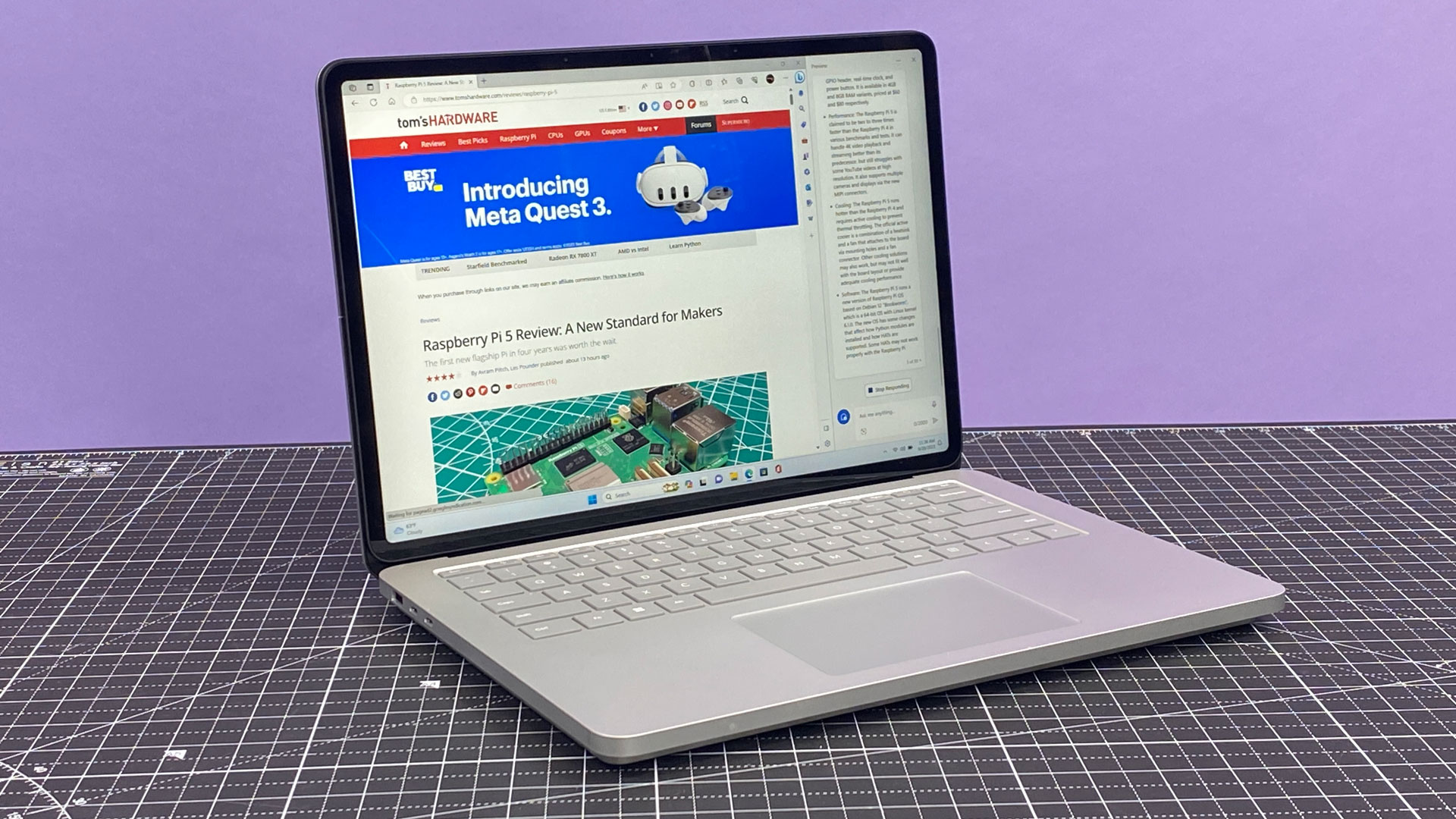
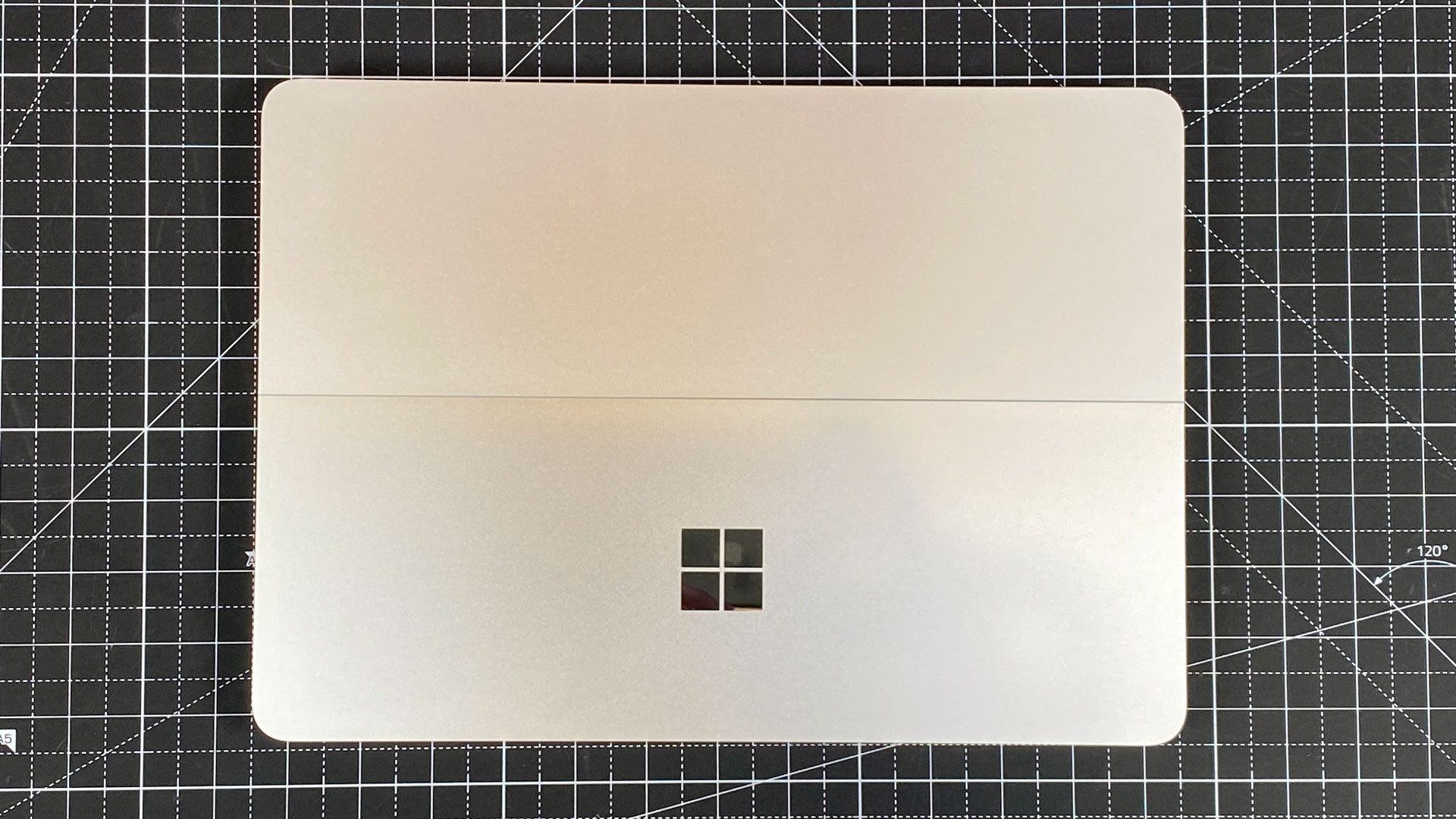
The Surface Laptop Studio 2's bendable "dynamic woven" hinge is still a rarity in laptops. You can use it as a normal laptop, bend it forward to focus on the monitor with external peripherals like game controllers, or turn it down into an easel for drawing, writing, or sketching.
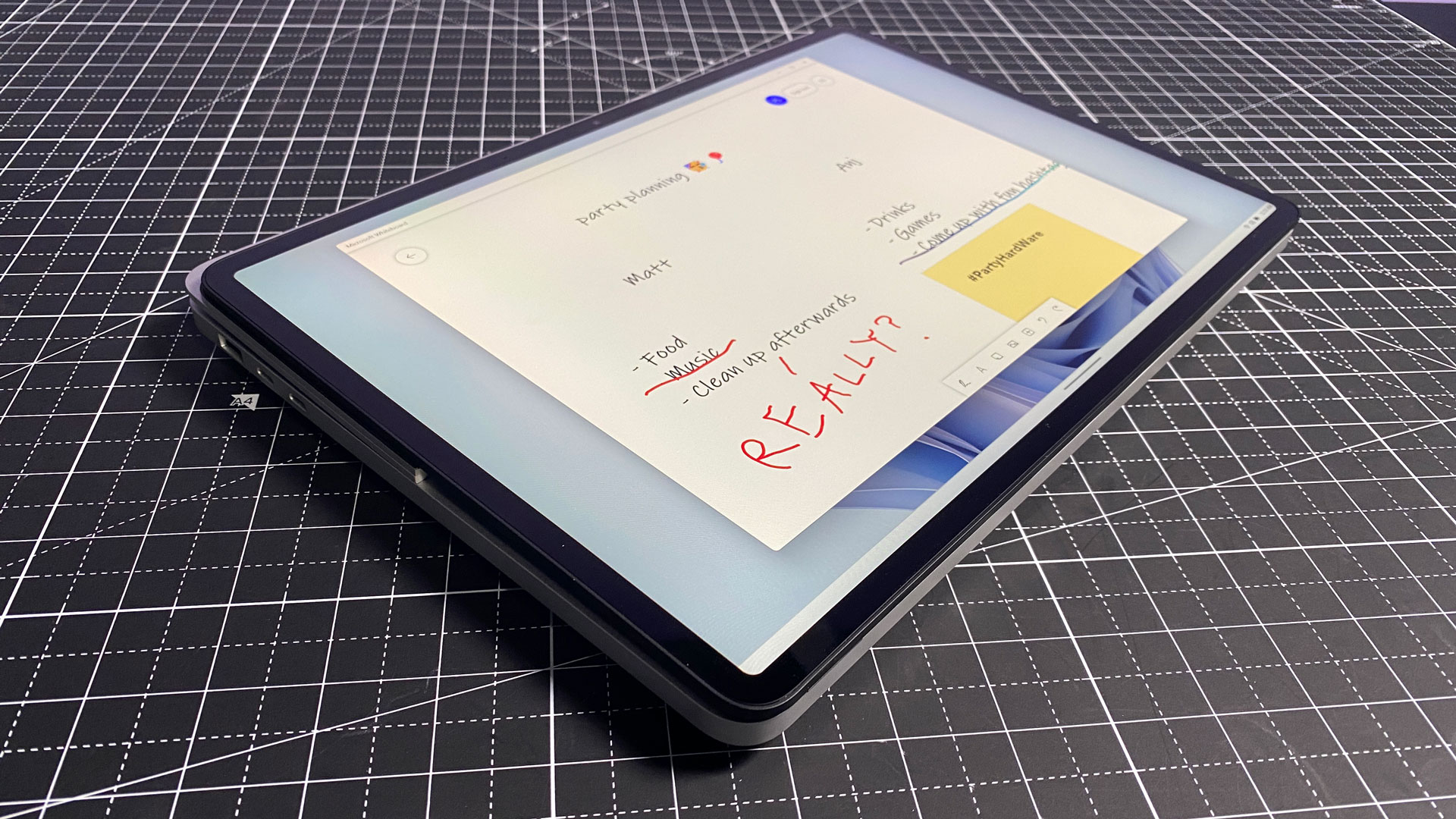

The changes are small, but they're useful. Beyond the spec upgrades, the biggest change for many will be additional ports. On the left side, Microsoft added a USB Type-A 3.1 port next to the two Thunderbolt 4 ports. It's rare that companies add legacy ports, but it makes sense here. Plenty of people use existing peripherals and storage drives, and if you're using the Studio as a creative tool, more connections can only help.
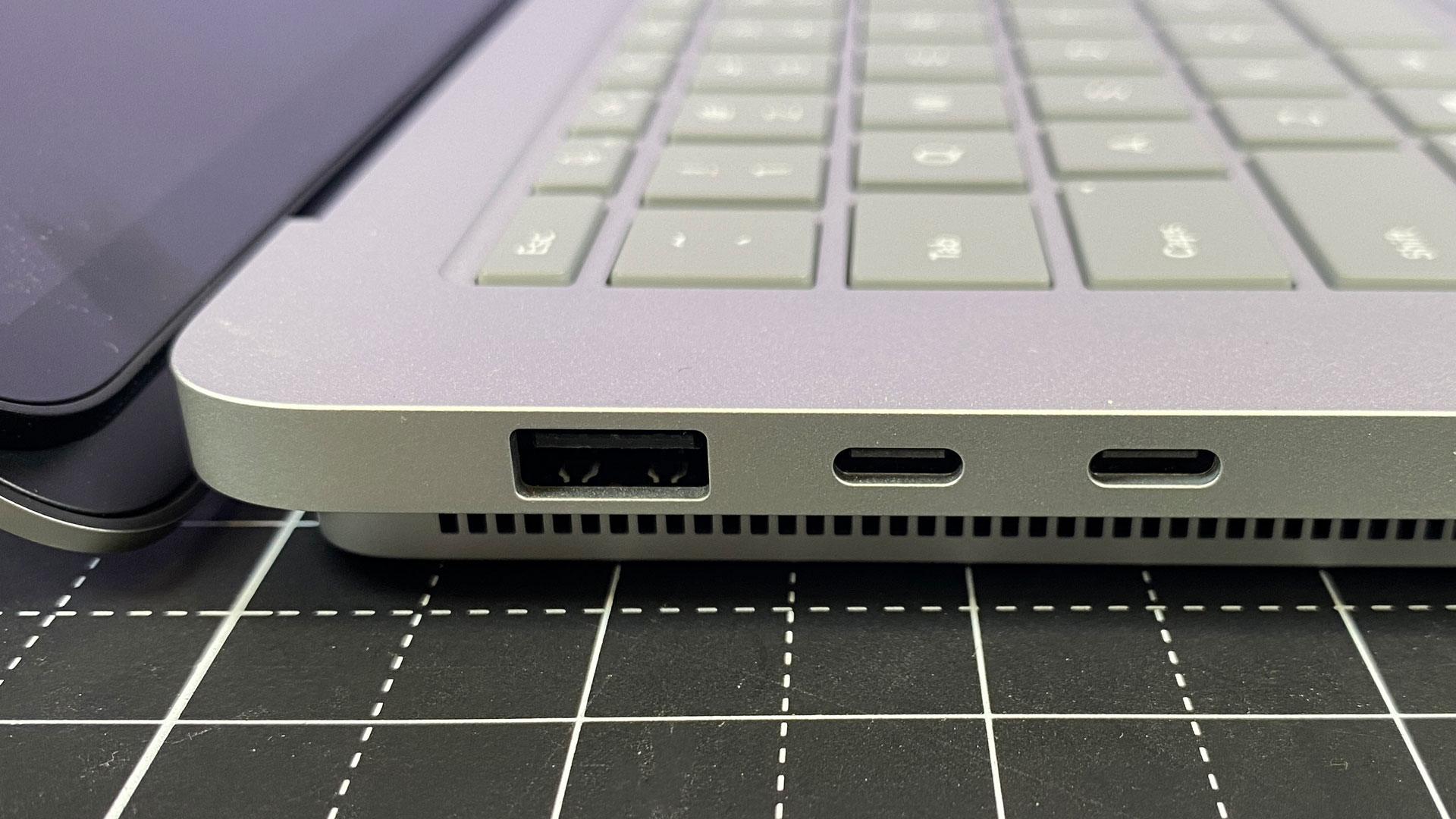
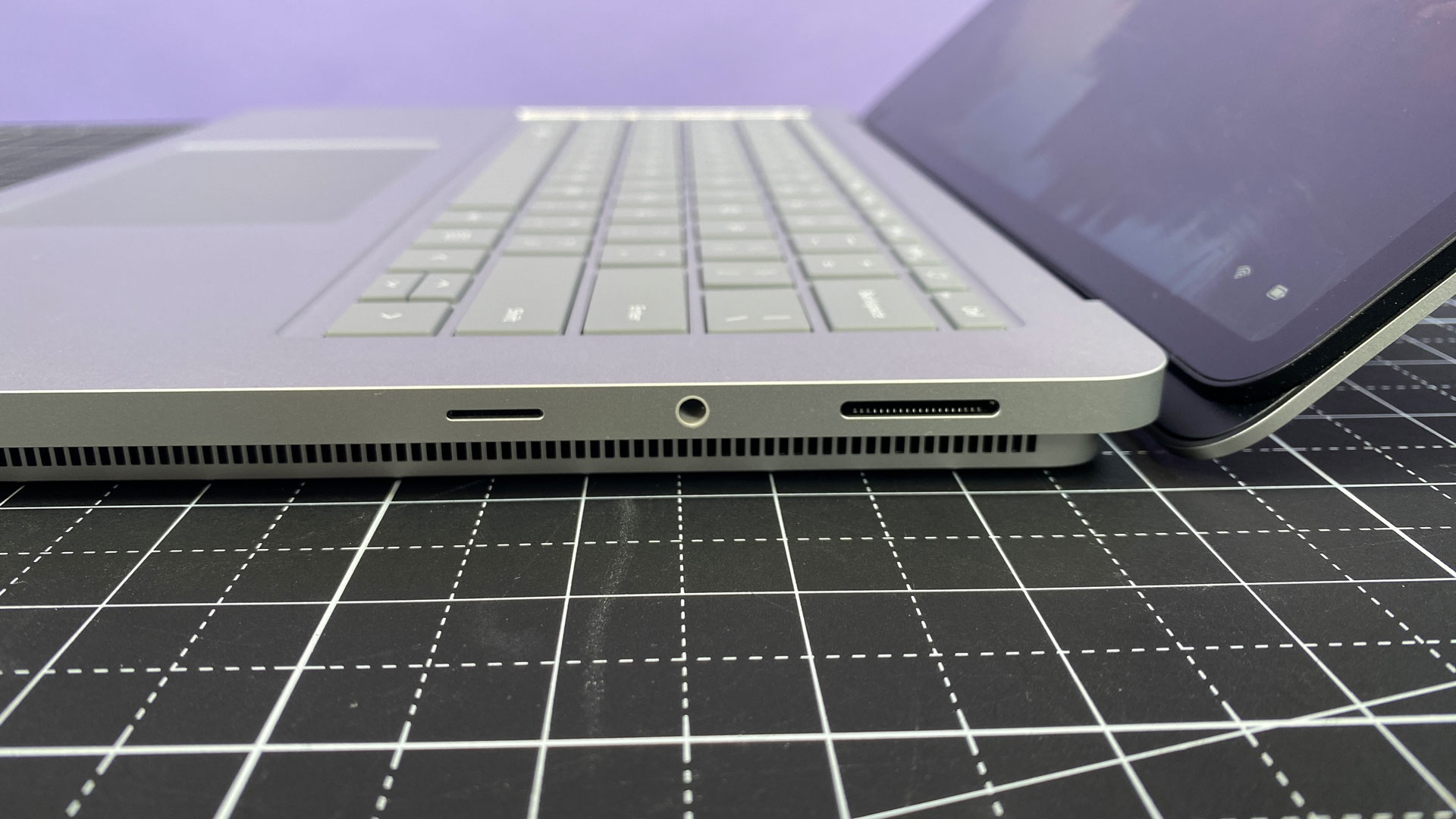
On the right side of the laptop, Microsoft has added a microSD card slot next to the proprietary Surface Connect charging and data port and the 3.5 mm headphone jack. I would've liked to see a full-sized SD card reader, but at least there's a way to expand storage.
Otherwise, the spartan silver Surface design is similar, including rounded corners, a reflective Surface logo, and silver color carry over from other Surface devices. The only real material change is to, well, the materials. Microsoft has switched to an anodized aluminum build compared to the typical Surface magnesium alloy. Additionally, the Laptop Studio 2 has gotten a bit thicker and gained some weight compared to its predecessor.
Get Tom's Hardware's best news and in-depth reviews, straight to your inbox.
The Surface Laptop Studio 2 measures 12.72 x 9.06 x 0.86 inches, compared to 12.72 x 8.98 x 0.75 inches on the original. And while the original Surface Laptop Studio weighed 4 pounds with an Nvidia GPU, this one weighs 4.37 pounds. This is a noticeable difference to me, but it makes some sense. For starters, it's using more powerful graphics cards, and that needs more cooling. But it's also using higher-wattage CPUs. The originals use 35W Tiger Lake Parts, but the Laptop Studio 2 uses a 45W Alder Lake Core i7. So that, too, likely needs more cooling, adding to the weight and size to fit it all.
The added weight makes it even more unwieldy to use as a tablet. A drawing tablet, sure. Laying back and reading your favorite website? Go detach your iPad or Surface Pro from its keyboard instead.
It's no surprise the 16-inch MacBook Pro with M2 Max is heavier, with a bigger display, at 4.8 pounds. But the Mac's got a slimmer profile at 14.01 x 9.77 x 0.66 inches. (The M2 Max can fit in the 14-incher, but that's not how we tested it.) The Dell XPS 15 (9530) is a lighter 4.23 pounds and 14.74 x 9.76 x 0.77 inches, and the Samsung Galaxy Book 3 Ultra was the featherweight of the group at 3.95 pounds and 14 x 9.86 x 0.65 inches.
The Surface still sits on a pedestal. It looks thin until you notice this. That area is what houses the components, as well as the cooling. It sucks air in through the back and expels it out the side, so your mouse hand may get toasty. I know mine did when I tried running games.
Microsoft Surface Laptop Studio 2 Specifications
| CPU | Intel Core i7-13700H, Intel Gen3 Movidus 3700VC VPU |
| Graphics | Nvidia GeForce RTX 4060 (8GB GDDR6), 2,010 MHz boost clock, 80W max graphics power) |
| Memory | 64GB LPDDR5X-5200 |
| Storage | 1TB PCIe Gen 4 SSD |
| Display | 14.4-inch, 3:2, PixelSense Flow (120 Hz), 2400 x 1600, touch |
| Networking | Intel Wi-Fi 6E AX210, Bluetooth 5.3 |
| Ports | 2x Thunderbolt 4, USB Type-A 3.1, MicroSD card, 3.5 mm headphone jack, Surface Connect |
| Camera | 1080p, IR |
| Battery | 58 WHr |
| Power Adapter | 127W |
| Operating System | Windows 11 Home |
| Dimensions (WxDxH) | 12.72 x 9.06 x 0.86 inches (323.09 x 230.12 x 21.84) |
| Weight | 4.37 pounds / 1.98 pounds |
| Price (as configured) | $3,299.99 |
Productivity Performance on the Microsoft Surface Laptop Studio 2
Microsoft has said this is the most powerful Surface it's ever made. That's true, if only because of spec upgrades; Our review unit packs an Intel Core i7-13700H with an Intel Gen3 Movidius 3700VC VPU to handle AI workloads, such as camera effects. It's also packing an Nvidia GeForce RTX 4060 and a 1TB PCIe Gen 4 SSD. Notably, it has 64GB of RAM — a first for the Surface line.
We compared the new Surface to a trio of powerful workhorses: the 16-inch MacBook Pro with M2 Max, the Dell XPS 15 (9530), and the Samsung Galaxy Book 3 Ultra. The latter two have the same CPU as the Surface.


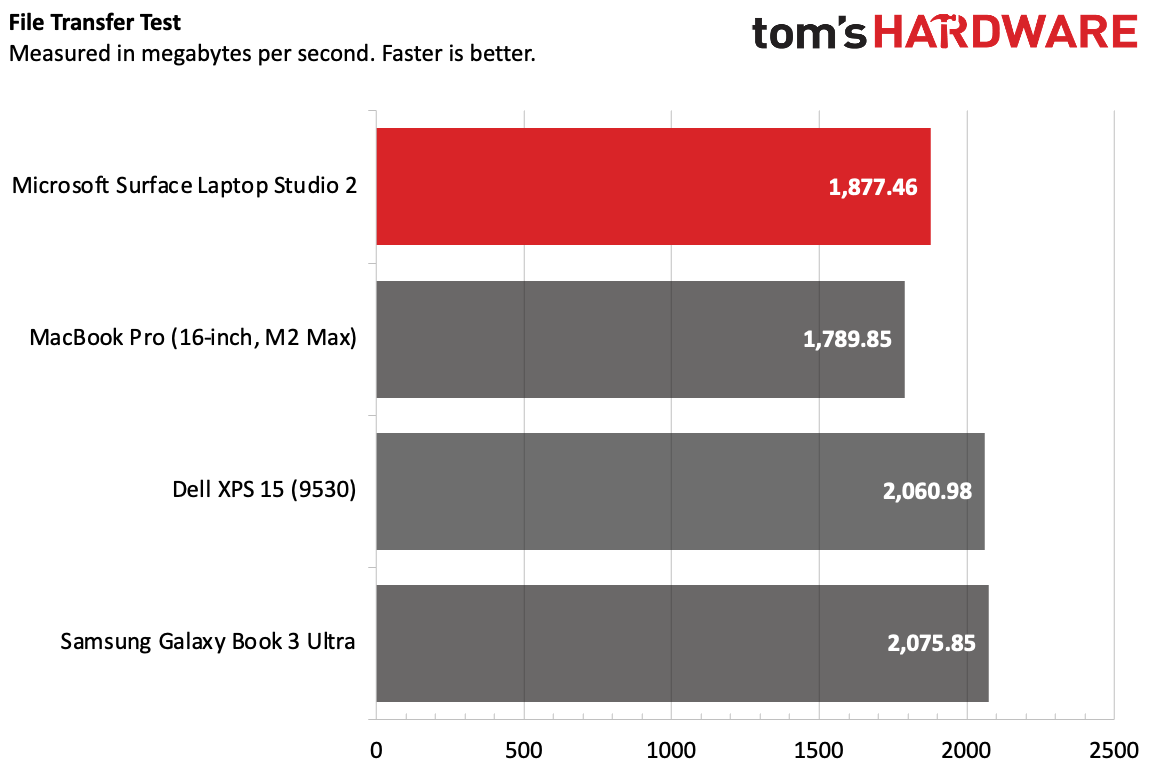
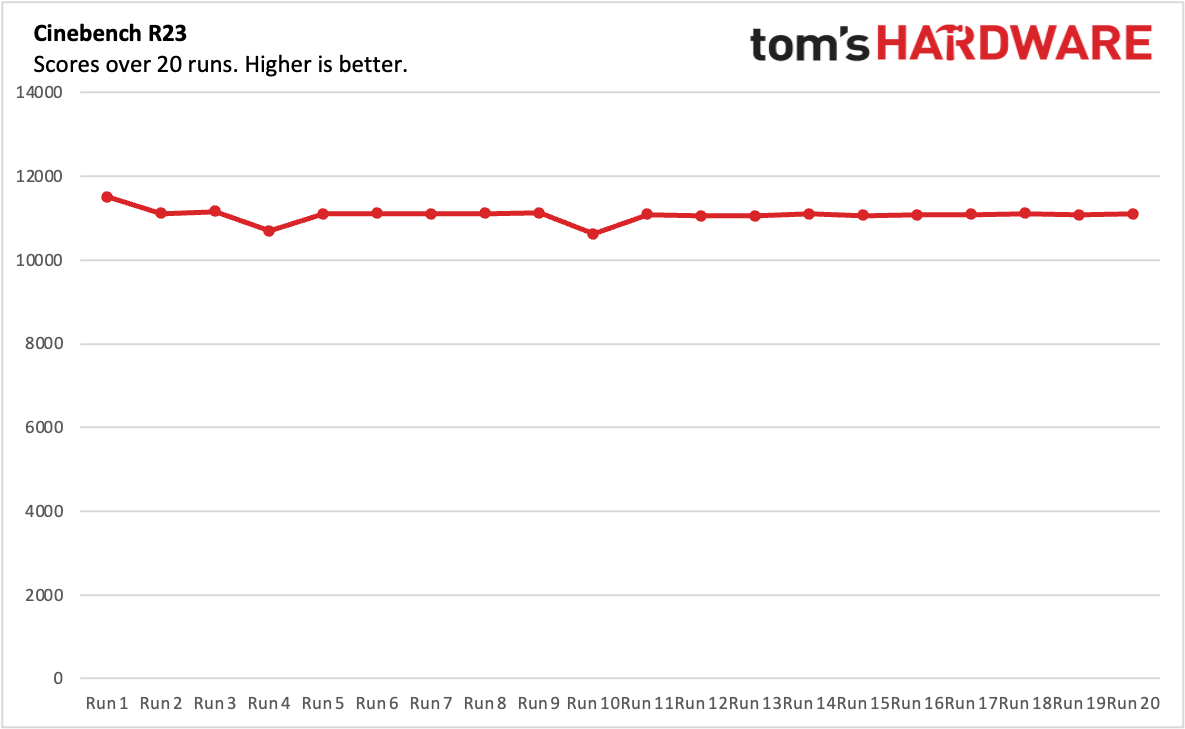
On Geekbench 5, a synthetic test that focuses on CPU performance, the Surface earned a single-core score of 1,851 and a multi-core score of 12,779. That was close to the Dell XPS 15, and it beat the single-core performance in the Samsung Galaxy Book 3 Ultra. Apple's M2 Max took top honors here, with a single-core score of 1,993 and a multi-core score of 15,173.
The Surface Studio's PCIe Gen 4 SSD coppied 25GB of tiles at a rate of 1,877.46 MBps. That surpassed the MacBook Pro, but fell behind both the Dell XPS 15 and Samsung Galaxy Book 3 Ultra, which each topped 2,000 MBps.
We use Handbrake to have laptops transcode 4K video to 1080p. The Surface Laptop Studio 2 took 5 minutes and 11 seconds to complete the task, falling between the XPS 15 and the Galaxy Book 3 Ultra. Here, the MacBook Pro flexed again, finishing at just 3:59.
To stress-test productivity machines, we run Cinebench R23 on a loop 20 times. The Surface Laptop Studio 2 was fairly stable, with most scores in the low 11,000's and just a few drops into the high 10,000's. The Core i7-13700H's six performance cores ran at an average of 2.48 GHz, while the eight efficiency cores averaged 1.93 GHz. The CPU measured 64.95 degrees Celsius.
Gaming and Graphics on the Microsoft Surface Laptop Studio 2
The Surface Laptop Studio 2 isn't a gaming machine, per se, but Microsoft did mention gaming around its debut, including showing it running Cyberpunk 2077's latest downloadable content.
We tested the Surface Laptop Studio 2 with an Nvidia GeForce RTX 4060, but Microsoft also sells it with an RTX 4050, RTX 2000 Ada (aimed at enterprise), and without discrete graphics at all. White the RTX 4060 is the most powerful GPU Microsoft offers, it's a low-power laptop variant with an 80W max graphics power and a 2,010 MHz boost clock.
That 80W max graphics power is consistent across the RTX 4050 and Ada 2000. In fact, the RTX 4050 has a higher max clock speed, but just 6GB of RAM instead of 8GB.
Anyway, yes, the Surface Laptop Studio 2 can game. But as you'll see from our charts, it can't always handle the settings we use for gaming laptops — especially if you want to run at the system's native resolution. You'll want to turn some options down, or consider using Nvidia's DLSS, where available, to improve performance and ensure at least 60 frames per second.

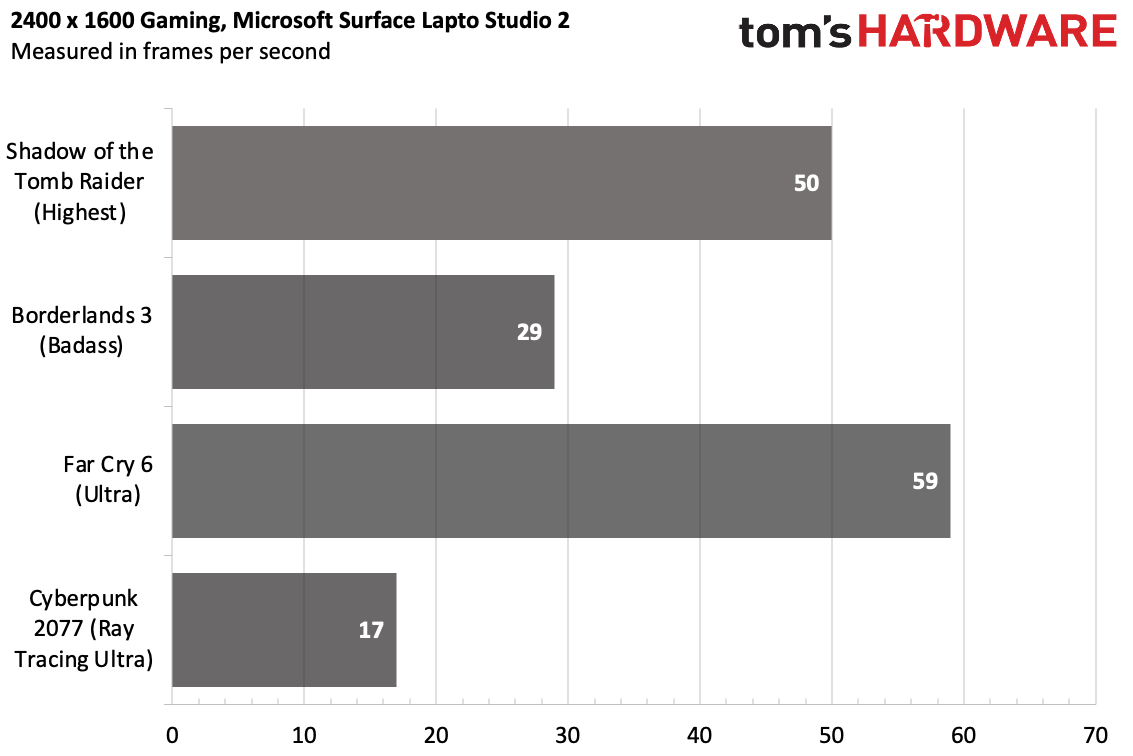
Display on the Microsoft Surface Laptop Studio 2
Every configuration of the Surface Laptop Studio 2 has a 14.4-inch, 3:2, 2400 x 1600, touchscreen. Microsoft calls this a "PixelSense Flow" screen, which basically means that you're getting a 120Hz screen with adaptive refresh.
It's quite bright. In a trailer for Aquaman and the Lost Kingdom, a scene where Aquaman walks in a jungle towards a volcano is filled with lush green and stunning blue flowers.
When we broke out our display measurement tools, we found that while the Laptop Studio 2 was the most luminous of the group, other displays are far more vivid.
The Surface Laptop Studio 2’s screen covers 102% of the sRGB gamut and 72.1% of the more challenging DCI-P3 gamut. That was the lowest of the group. The MacBook Pro and Samsung Galaxy Book 3 Ultra both had significant bumps above that, but it was the Dell XPS 15's OLED panel that won out at 195% of the sRGB gamut and 137.9% of the DCI-P3. (The XPS, however, had the lowest brightness. That's a tradeoff, putting the Mac and Galaxy in the best positions in my eyes.
Keyboard and Touchpad on the Microsoft Surface Laptop Studio 2
I've typically enjoyed Microsoft's laptop keyboards, so it wasn't much of a surprise to me that the one on the Surface Laptop Studio 2 is still pretty great. With 1.3mm of travel, It's firm, but still clicky, and I never felt like I was hitting the bottom. On the monkeytype typing test, I reached 121 words per minute. Perhaps my only major complaint is that the up and down arrow keys are bunched together.
The keyboard does feel a bit high up: the system rests on a platform, after all. But it's not much different from typing on a thick gaming laptop or workstation computer.
There's a change to the haptic touchpad, which many may not notice, but is great for those who will benefit. Specifically, a new Adaptive Touch feature is designed for people who are unable to use a standard touchpad, which typically requires easy use of your fingers. It's buried in the Surface app (see "Software and Warranty" below), rather than the Windows settings, but lets you use your "knuckle, palm, or other body part" on the touchpad, though some gestures won't work with it turned on. While I have full use of my fingers on both hands, I was able to navigate with my fist, knuckles, and, to a lesser extent, my forearm.
Otherwise, the touchpad works exactly the same. The haptic touchpad is adjustable (though I was fine with the simulated pressure out of the box), and it's great with multi-finger gestures.
While Microsoft loaned us a review unit, it didn't include a Surface Slim Pen 2. That pen can attach to the bottom lip of the Laptop Studio for wireless charging, and also has some built-in haptic feedback to simulate writing on paper. We did test this stylus two years ago with the original Surface Laptop Studio, if you want more details on it. The stylus is $129.99, but I consider it a bit of a necessity to get everything out of this system, unless you never intend to sketch or write in the tablet mode.
Audio on the Microsoft Surface Laptop Studio 2
Microsoft's quad speakers with Dolby Atmos Support are powerful and loud, easily filling a room. "The District Sleeps Alone Tonight" by the Postal Service sounded great, with clear vocals, pronounced bass (on a laptop, I know!), and well-balanced guitars and synthesizers. It's not the best I've ever heard, but they're pretty good.
But one thing about the speakers was distracting: I could feel them under my wrists when I typed while listening to music. Especially at higher volumes, the speakers vibrated hard enough that I could feel them through the chassis.
The speakers do have a few other quirks. For one, turning them up past 85% or so can sound a bit like the speakers are blowing out, decreasing sound quality the higher you go. A comfortable 70-80% should work for most.
The other quirk is, like the original Laptop Studio, the sound seems to be coming up through the keyboard. When you slide the screen down into tablet mode, it slightly muffles the sound, so you may want to have headphones on hand if you draw and listen to music at the same time.
Upgradeability on the Microsoft Surface Laptop Studio 2
In general, you should assume that the Microsoft Surface Laptop Studio 2 isn't upgradeable. There are no exposed screws on the bottom, and Microsoft still hasn't added the SSD door that you get on the Surface Pro 9.
Microsoft claims the SSD is upgradeable, but in the footnotes of the Surface Laptop Studio 2 site, says it's only meant for an authorized Microsoft repair technician to change out.
Microsoft does have a page dedicated to self-repair for Surfaces, but as of this writing, it doesn't yet feature the Surface Laptop Studio 2 (or the Surface Laptop Go 3). I imagine those components and instructions will come eventually.
When you configure your Surface Laptop Studio 2, consider your parts carefully. Those will largely be what you're stuck with.
Battery Life on the Microsoft Surface Laptop Studio 2
If you don't run the Surface Laptop Studio 2 too hard, you can get through a day. On our battery test, which browses the web, streams video, and runs OpenGL graphics tests on a loop while connected to Wi-Fi with the screen at 150 nits, the Surface Laptop Studio 2 lasted for 9 hours and 31 minutes. While that beat the XPS 15 and Samsung Galaxy Book 3 Ultra (9:12 and 9:03, respectively), Apple's MacBook Pro 16 ran for 18:56, blowing the Intel-based field away when it comes to endurance and efficiency.
Heat on the Microsoft Surface Laptop Studio 2
The Laptop Studio 2 has more powerful hardware, but that thicker chassis must pack more cooling, because it ran quietly on our Cinebench stress test. Of course, we also took some thermal images.
At the center of the keyboard, between the G and H keys, the laptop measured 36.2 degrees Celsius (97.16 F).
Meanwhile, the hotspot on the bottom of the notebook hit 36.4 C (97.52 F).
Webcam on the Microsoft Surface Laptop Studio 2
The 1080p webcam on the Surface Laptop Studio 2 is pretty solid. It's not as good as the best webcams out there, but I found that Microsoft's lens was fairly sharp and good with color accuracy. With a bit of time to focus, it even managed to handle our office's awful fluorescent lighting and keep the image from getting too warm.
The webcam is one of the easiest places to demonstrate the use for the Intel Movidius NPU (Intel calls it a "VPU," or vision processing unit, but Windows, and seemingly the rest of the industry, have gone with NPU — neural processing unit). In calls, I was able to use Windows Studio Effects, like blurring the background and auto-framing, and the NPU showed in the Task Manager that it was doing the heavy lifting. That leaves the CPU and GPU to do other work. You just need to set that up in the Surface app beforehand, rather than doing it through Zoom, Teams, or Google Meet.
Software and Warranty on the Microsoft Surface Laptop Studio 2
One of my favorite benefits of Microsoft making its own hardware is that Windows 11 isn't bogged down with a ton of third-party software and antivirus trials.
The only extra app here is Microsoft's Surface software. It provides you with device information, lets you adjust smart charging, check warranty coverage, adjust camera effects, and change stylus settings. The unfortunate change Microsoft has made is that in a "recommended" section, similar to the Start Menu, but with links to buy accessories. I don't like to be advertised to in my settings software.
Otherwise, there are still the links to the Microsoft Store in the Start Menu, like Spotify, WhatsApp, and Kindle, but not much else.
Microsoft sells the Surface Laptop Studio 2 with a one-year warranty. Though for an additional fee, you can extend it up to four years with the Microsoft Complete plans.
Microsoft Surface Laptop Studio 2 Configurations
The Surface Laptop Studio 2 starts at $1,999.99, but without the powerhouse components. For that price you get an Intel Core Core i7-13700H - the same chip as every model, and the Intel Gen 3 Movidius 3700VC VPU, 16GB of RAM, a 512GB SSD and Intel Iris Xe integrated graphics.
We tested a $3,299.99 configuration, using the same CPU and VPU, but with an Nvidia GeForce RTX 4060, 1TB SSD, and 64GB of RAM (this is the first time a Surface has offered that much memory).
There are models with a lower-end RTX 4050, starting at $2,3.99 (16GB RAM/512GB SSD) and going up to $2,799.99 (32GB RAM/1TB SSD).
On the high-end, there's a $3,699.99 option with the same Core i7, 64GB of RAM, and RTX 4060 but with a 2TB SSD. That's a $400 upcharge for a 1TB increase!
Outside of the gaming-grade GPUs, a version with 32GB of RAM, a 1TB SSD, and Nvidia RTX 2000 Ada meant for professional use is $3,599.99.
The RTX laptops are running Nvidia Studio drivers, which are meant for artists, developers and other professionals to get the most stable performance in creative software.
Bottom Line
Despite two years between the original and this revision, the Surface Laptop Studio 2 is an incremental, albeit meaningful, update. The ports should've been there from the start, but better late than never, and the spec bump will be significant for those who use discrete graphics in their daily workloads.
The Surface Laptop Studio 2 is a bit heavier and thicker than its predecessor, and in that way, it feels less graceful. If you don't need Microsoft's unique design, the XPS 15 and Galaxy Book Ultra 3 might serve you as thinner, more attractive options.
If you're willing to move off of Windows to macOS, the 16-inch MacBook Pro with M2 Max bested the Surface in several tests and is also incredibly sleek. But if you need Nvidia's GPU, want access to a wide gaming catalog, or have workflows that only work on Windows, that may not be an answer for you.
Ultimately, the Surface Laptop Studio 2 stands out the most because of its hinged screen, and it is one of very few designs like it — especially with this kind of power under the hood. If the combination of a regular laptop and a flat surface for sketching will keep you in the zone, the Surface Laptop Studio 2 stands apart.

Andrew E. Freedman is a senior editor at Tom's Hardware focusing on laptops, desktops and gaming. He also keeps up with the latest news. A lover of all things gaming and tech, his previous work has shown up in Tom's Guide, Laptop Mag, Kotaku, PCMag and Complex, among others. Follow him on Threads @FreedmanAE and BlueSky @andrewfreedman.net. You can send him tips on Signal: andrewfreedman.01
-
Giroro Before you get mad at Microsoft for continuing to overprice their hardware to an extreme degree, you have to remember Surface hardware is exclusively designed to be purchased by highly paid Microsoft employees who reside in Redmond Washington, a place where your average dollar is worth 30 cents. A small pool of potential customers who, ironically, all get these for free.Reply
These suits must work really hard too. You can tell because they obviously haven't had any free time to leave the Microsoft bubble and observe the real value of a dollar in years, if not decades.
You were never going to buy one because you aren't the target market for Microsoft hardware. Nobody is. -
Alvar "Miles" Udell A great advertisement for the Dell XPS 15 (9530), and another great article showing why Surface products are incredibly overpriced compared to the competition for what you get. The Dell is $500 less (as listed on the TH article), and for the tradeoff of 32GB RAM (which you can upgrade), you get an OLED screen and better GPU, and, more importantly for creators, 137% DCI-P3 coverage vs 72% on the Surface.Reply

